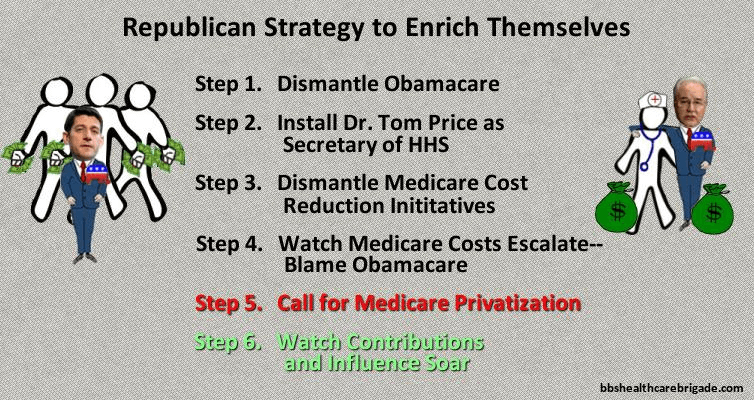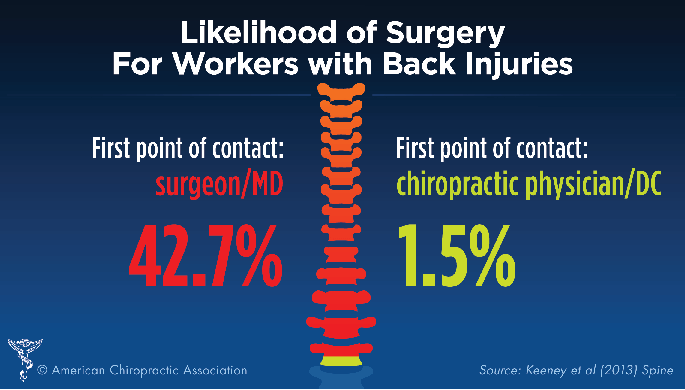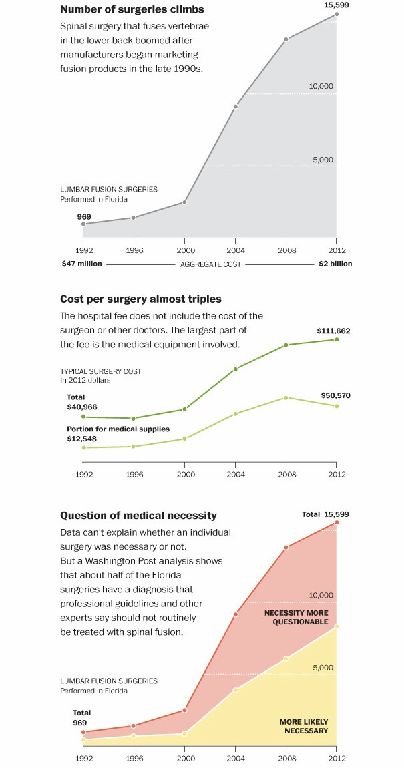Discounted Price
Finally I agree with Don Trump on one issue—not the Muslim ban, the repeal of DACA, building the Mexican wall, firing James Comey, demonizing NFL players, or his attempts to repeal and replace Obamacare.
But I do agree with Trump when he fired Secretary Tom Price not only because of his imprudent use of private planes at taxpayers’ expense, but Dr. Price was undoubtedly the worst possible selection for the chiropractic profession to head our nation’s many healthcare systems.
Price vs. Chiropractic
I cheered Dr. Price’s ouster because as long as he was in charge of HHS, chiropractors’ progress would have been obstructed, marginalized and the issues surrounding spine surgery would continue to be ignored, namely the paradigm shift from medical spine care to nondrug and nonsurgical care such as chiropractic.
Indeed, there is no way an orthopedist would implement the numerous new ACP guidelines on chronic back pain, nor would he have taken seriously endorsements of chiropractic to help fight in the opioid battle and reduce the high costs of spine care.
Dr. Price obviously prefers the present medical system just the way it is with MDs in charge of every aspect of healthcare in order to protect their medical monopoly with high costs despite their poor outcomes, especially with back surgeries, a specialty that made Dr. Price a wealthy man.
I cannot image anyone more opposed to our profession than Dr. Price, an orthopedist, who politically and financially has no interest to reform medical spine care or helping chiropractors expand their role as the new guidelines recommend.
Price’s chirophobia is an important hidden agenda because the power of the Secretary of the Department of Health and Human Services is immense, controlling Medicare, Medicaid, the Affordable Care Act’s federal health insurance exchange, the National Institutes of Health, the Food and Drug Administration and the Centers for Disease Control and Prevention.
Many news pundits suggest Trump’s appointment of Dr. Tom Price was aimed to facilitate the downfall of Obamacare, but it also would curtail the reform efforts in Obamacare to improve America’s expensive and ineffective medical care, as well as detect fraud by physicians and price-gouging by hospitals.
Price Air Sick
When Congress was debating the authorization of funds for private jets in 2009, ironically Tom Price said “This is just another example of fiscal irresponsibility run amok.”

Not only did Dr. Price run amok himself with his 24 flights on private planes costing anywhere from $400,000 to $1,000,000 (depending upon who’s counting), during Price’s confirmation hearing Senator Al Franken (D-MN) also revealed Price’s questionable ties to Big Tobacco as a physician/stockholder as well as his conflict of interest as a legislator with companies he had investments.
For example, according to The Wall Street Journal, “HHS Secretary Tom Price tripled his investment on biotech stock bought at a discount” and, after an investment of only a few months, he made at least $225,000 on a $94,000 investment in Innate Immunotherapeutics, suggesting insider-trading.
In the same senate hearing, Senator Elizabeth Warren (D-MA) questioned Price about his budget proposal to cut Medicare by $400 billion and Medicaid by over $1 trillion despite President Trump’s promise not to cut either.

Questionable Price
The initial appointment of Price raised concerns from many who could see the writing on the wall about his past performances laden with controversies and conflicts of interest.
- According to Kaiser Health News:
“… in picking Tom Price to be secretary of Health and Human Services, Donald Trump has chosen an orthopedic surgeon who in his congressional career has loyally promoted the interests of the medical profession — its freedom and importantly, its financial interests.”
- According to Modern Healthcare, Deregulation agenda expected to continue despite Price’s resignation:
“Industry observers noted that several of the department’s moves under his leadership predominantly helped physicians. A new secretary may broaden the scope of the deregulation agenda. It’s hard to imagine that the medical community will find anyone better. Physicians may feel a little nervous; like their protector is gone.”
- An article in STAT News, “With Tom Price in charge, doctors are winning again in Washington,” found Price inexplicably cited the “victims of Obamacare” were mainly physicians who felt the law was hurting their own bottom lines:
“And over and over again, he has delayed Obama-era regulations that would have penalized doctors who aren’t ready or able to move away from Medicare’s longstanding ‘fee-for-service’ approach.”
That may or may not mean better care for patients, but it certainly means more money and less interference for doctors and higher health-care costs for everybody.
- An article in the New York Times, “Trump’s Health Secretary Pick Leaves Nation’s Doctors Divided,” confirmed the selection of Price as “the best friend that physicians and patients have ever had in that role”:
“For those who are attacking Dr. Price, I have to ask whom you would rather have at the helm of H.H.S. — a career bureaucrat? A former governor who views doctors as a cost center to be controlled?” said Dr. Robert E. Hertzka of San Diego, an anesthesiologist and former president of the California Medical Association.
Let me answer with a resounding “yes” to his hypothetical question! Certainly the cost of the medical monopoly must be contained; in fact, breaking up the monopoly is the best solution to real reform!
Dr. Hertzka also mentioned, “Tom Price may turn out to be the best friend that physicians and patients have ever had in that role.”
I doubt Dr. Price would be considered the “best friend” to patients after his recommendation to decrease coverage for Medicare/Medicaid, but to physicians, especially orthopedists, he definitely would have been their protector to maintain their excessive surgeries and salaries.
The average annual salary of a spine surgeon is now the highest of all doctors at $806,000 according to Bloomberg News.[i] This salary does not include the royalties and commissions paid by surgical hardware manufacturers that often top the million-dollar level as The Wall Street Journal revealed in, “Top Spine Surgeons Reap Royalties, Medicare Bounty.”[ii]
For Tom Price, with a net worth of approximately $14 million, medicine has always been about making a lot of money and there is no way he wants the public to know the cost and clinical ineffectiveness of medical spine care—there is simply too much money and too few ethics involved to tell the truth.
- Instead of a progressive reform-minded leader, according to the New York magazine, “Tom Price’s Old-School Approach at HHS Is Just What the Doctors Ordered,” Price represents a return to the Bush-era healthcare with the medical establishment in charge with little government oversight:
“In many ways, Price’s regulatory changes represent a return to an earlier time…At a time when the entire political spectrum professes to believe that health-care-cost containment is hugely important to the country, that’s a problem. But Price, out of long habit, may be looking back and fighting old battles rather than looking ahead.”
If he had remained in office, our country would have resorted back to Bushcare with HMOs in charge limiting coverage to patients with pre-existing conditions, with high premiums and low payments to physicians. Indeed, it would be the return of their motto: “squeeze care to expand profits.”
· According to an article in the New York Times, “In Health Care, ‘Fee for Service’ Is a Perverse Incentive,” the American healthcare system is sick not only in terms of huge costs, but “The problem with shifting patients toward hospital systems is that hospitals’ financial goal is to get patients into beds.”
Not only do surgeons profit greatly, so do hospitals, which explains why for-profit hospitals do not want chiropractors on staff because our patients do not need hospital beds.
The top seven hospitals collected more than $33.9 billion in total operating revenue in 2015, up from $29.4 billion in 2013 before the Affordable Care Act took full effect.[iii] For an industry that seems to not want much to do with the Obamacare, they have lobbied hard against changing this cash cow.
If chiropractic were to have an equal footing and patients were to have equal access as the new guidelines suggest, chiropractic care would also slow down back surgeries run amok as Keeney et al found in a comparative study finding 42.7% (medical PCP) vs. 1.5% (chiropractic PCP).

However, protecting the medical status quo was Price’s mission, not containing the outrageous cost of medical spine care and certainly not helping chiropractors increase their market share.
Obviously the new research and evidence-based guidelines would have had no impact upon Sec. Price. Undoubtedly he would have been reviled by his surgical colleagues at the next North American Spine Society (NASS) conference if he had supported the paradigm shift to nondrug, nonsurgical care as the American College of Physicians (ACP) updated guidelines recommends.
Indeed, Price would rather shoot himself in the foot (or have back surgery himself) than to fully integrate chiropractors. Obviously as an orthopedic surgeon, he had no interest in supporting any guideline that would decrease the volume of spine surgeries or the market share of the NASS.
Price was appointed to kill Obamacare and, along the way, protect his vested interests, and certainly not to help DCs improve their market share or to expand their role in the fight against opioids or chronic pain.
Medical Denial
It’s not as if this scandal in spine surgery is unknown to Dr. Price or other spine surgeons. I wrote about one ethical spine surgeon who made no bones about this impropriety in spine care and his ideas have now proven prophetic.
James Ausman, MD, PhD, emeritus editor in chief of Surgical Neurology International, wrote an editorial, “The Death of Spine Surgery, Sequel–2014,” that make my comments seem pale in comparison.
Here’s an excerpt from his editorial where he portrays himself as the new Secretary of Health addressing the spine care fiasco who states “…there is evidence that too much surgery is being done at too great a cost.” (I seriously doubt Sec. Tom Price shares his sentiments):
In 2003, I wrote an Editorial on “The Death of Spine Surgery”, which was received with denial by spine surgeons and still is today. If I were the Secretary on Health in any government concerned about costs for healthcare and I was informed about the 15× increase in complex surgery, 3× higher costs with no increase in the disease process, my first question to my assistant would be, “Where is the evidence to justify these costs? The answer would be “There is no scientific justification.” In fact there is evidence that too much surgery is being done at too great a cost. The first action I would take, as would any 6th grader, would be to stop payments for the complex procedures until justification was established.
Dr. Ausman admonished his colleagues by suggesting they “read the newspaper headlines of tomorrow” with these accusatory headlines:
- Doctors Conspire with Industry to Use Unnecessary Treatments.
- Patients Receiving Unnecessary Treatments from Neurosurgeons, Orthopedists, and Pain Doctors.
- Healthcare Costs Escalated by Doctors and Industry.
- Congress Calls for More Controls on Physicians.
He concluded, “If you do not see where this is headed, you are in denial.”
This blindness is not only due to denial as much as it is due to greed considering most spine surgeons simply do not care about guidelines as long as they make money, which explains why spine surgeons are the wealthiest of all physicians.
Fortunately, others have spoken out about this “poster child” of inefficient spine care. The Washington Post published “Spinal fusions serve as case study for debate over when certain surgeries are necessary” showing the number of fusion surgeries increased 600-700% since 2000. The costs of the surgeries have nearly tripled due to the expensive hardware being implanted. Keep in mind about half of the surgeries are considered unnecessary and lead to failed back surgery syndrome.

Certainly the role of excessive and ineffective spine surgery cannot be overstated as an issue any Secretary of HHS must address as Dr. Ausman suggests, but one Dr. Price ignored without comment when the new guidelines were announced in February, 2017.
Controversial Price
Sec. Price knew full well the controversies in spine care—the opioid addiction, the rash of ineffective, “underwhelming” ESIs, and tsunami of unnecessary spine fusions. If any other segment of medicine was as expensive and deemed the “poster child” of inefficient care, undoubtedly he would have called for an investigation. But as an orthopedist profiting from this medical scam, he turned a blind eye.
Unfortunately, Dr. Price and his ortho colleagues will never admit their misdiagnosis and mistreatments for nonspecific LBP has led to the current crisis considering spine care is the leading cost in healthcare, more than cancer, heart disease and diabetes.[iv]
According to Steven H. Stern, MD, MBA:
“Among the most common reasons for admission for in-patient care in the United States, lumbar spinal fusion is the most expensive. And I will tell you it is ahead of what is in second place by about 50 percent…Spine care spending is rising faster than overall medical spending.”[v]
The top seven hospitals collected more than $33.9 billion in total operating revenue in 2015, up from $29.4 billion in 2013 before the Affordable Care Act took full effect.[vi] For an industry that seems to not want much to do with the Obamacare, they have lobbied hard against changing this cash cow.
The global market for spinal surgery is projected to reach $9.3 billion by the year 2017.[vii] A report on the spine surgery market forecasts the global spine surgery devices market will be worth $14.8 billion by 2017.[viii] Hospitalization for spinal fusion surgeries alone creates the largest expenditure of any hospital-based surgery at over $40 billion annually.[ix]
Not only are surgeons and hospitals cashing in on this rampage of fusions, so has Big Pharma. Prescription opioid painkillers for back pain brought in $17.8 billion, and OxyContin alone made $3 billion in 2010.[x]
As you can see, the medical spine industrial complex has no interest in following guidelines restricting their products, and considering they are the largest medical lobby on Capitol Hill, they have the power to ignore guidelines with the blessings of congressmen as I discovered with my US Rep. Austin Scott whose father is an orthopedist.
Not only expensive, new research suggests that of the 500,000+ disc surgeries that are performed annually, many are unnecessary and ineffective. In fact, a 2017 study by Clancy et al., The Aetiologies of Failed Back Surgery Syndrome: A systematic review, found up to 50 percent of patients will develop Failed Back Surgery Syndrome (FBSS) following lumbar spine surgery.
Another 2017 study in Spine by Panagopoulos et al, Do MRI Findings Change Over a Period of up to 1 Year in Patients with Low Back Pain and/or Sciatica? reported the natural reduction of herniated discs: “15% to 93% of herniations reduced in size or disappeared without surgery.”
Not only are most spine fusions unnecessary and ineffective, a study in 2013 by Epstein and Hood, Are recommended spine operations either unnecessary or too complex? Evidence from second opinions, suggests 94.0% of cases were given unnecessary or wrong recommendations. The second opinion surgeon documented the previous spine surgeons’ recommendations were:
- “unnecessary” (60.7%)
- “wrong” (33.3%) or
- “right” (6%) operations.
As you can see, back surgeries are now deemed by many to be the biggest scam in medicine with poor outcomes, high costs, with a high rate of being unnecessary and complete failures.
Is this not an issue the Sec. of HHS should address?
What America needs is an objective and honest leader (such as Dr. Ausman) who understands the medical monopoly is out of control and ineffective compared to other developed countries of the world rather than Dr. Price whose goal was to dismantle rather than refine and reform Obamacare.
[i] Peter Waldman and David Armstrong, “Highest-Paid U.S. Doctors Get Rich with Fusion Surgery Debunked by Studies” Bloomberg News, Dec. 30, 2010.
[ii] John Carreyrou and Tom McGinty, “Top Spine Surgeons Reap Royalties, Medicare Bounty,” Wall St. Journal, Dec. 20, 2010
[iii] Diamond D. How hospitals got richer off of Obamacare. Politico. July 17, 2017. http://www.politico.com/interactives/2017/obamacare-non-profit-hospital-taxes/ Accessed September 23, 2017.
[iv] Optum. Conservative Care: Ensuring the Right Provider for the Right Treatment, 2012.
[v] SH Stern, “Value and Spine Care: A private payer’s perspective,” presented at the annual meeting of the North American Spine Society, Orlando, Florida, 2010; as yet unpublished.
[vi] Diamond D. How hospitals got richer off of Obamacare. Politico. July 17, 2017. http://www.politico.com/interactives/2017/obamacare-non-profit-hospital-taxes/ Accessed September 23, 2017.
[vii] http://www.prweb.com/releases/spinal_surgery_devices/spinal_fusion_fixation/prweb8977144.htm
[viii] http://www.marketsandmarkets.com/PressReleases/spine-surgery-devices.asp
[ix] HCUPnet. Agency for Healthcare Research and Quality. Available at: http://hcupnet.ahrq.gov/HCUPnet.jsp. Accessed October 30, 2014.
[x] Rafia S. Rasu, BPharm, MPharm, MBA, PhD; Kiengkham Vouthy, PharmD; Ashley N. Crowl, PharmD; Anne E. Stegeman, PharmD; Bithia Fikru, PharmD, MPA; Walter Agbor Bawa, MS, PharmD; and Maureen E. Knell, PharmD, BCACP, “Cost of Pain Medication to Treat Adult Patients with Nonmalignant Chronic Pain in the United States,” Vol. 20, No. 9 September 2014 JMCP Journal of Managed Care & Specialty Pharmacy